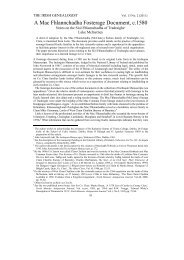Report Cover Vol I - Clare County Library
Report Cover Vol I - Clare County Library
Report Cover Vol I - Clare County Library
You also want an ePaper? Increase the reach of your titles
YUMPU automatically turns print PDFs into web optimized ePapers that Google loves.
The <strong>County</strong> <strong>Clare</strong> Wetlands Survey Patrick Crushell & Peter Foss 2008<br />
_______________________________________________________________<br />
Soils of turlough basins can include marls, peat, clays or loams. Large boulders or exposures of bedrock<br />
may also be present.<br />
Turloughs support a range of different plant communities that comprise a mixture of aquatic, amphibious<br />
and terrestrial species. Plant communities typically form a concentric pattern around the basin; the<br />
different zones reflect differences in the extent<br />
and duration of flooding. Wet grassland usually dominates and characteristic species include Creeping<br />
Bent (Agrostis stolonifera), small sedges (particularly Carex nigra and C. panicea), Silverweed (Potentilla<br />
anserina), Meadowsweet (Filipendula ulmaria), Creeping Buttercup (Ranunculus repens), Marsh<br />
Pennywort (Hydrocotyle vulgaris) and Amphibious Bistort (Polygonum amphibium). Permanent pools,<br />
channels and lakes may also be present and may support Common Spike-rush (Eleocharis palustris),<br />
Water-plantain (Alisma plantago-aquatica), pondweeds (Potamogeton spp.), and tall reeds such as<br />
Common Club-rush (Schoenoplectus lacustris).<br />
Links with Annex I: Corresponds to the priority habitat, '*turloughs (3180)'.<br />
FL7 Reservoirs<br />
This category incorporates all open water bodies that are used for the storage and supply of water. It<br />
includes natural lakes where water levels fluctuate significantly and unnaturally as a result of abstraction,<br />
in addition to modified lakes with dams or retaining walls or banks. Entirely artificial water bodies, some<br />
lined with concrete, that are used as reservoirs are also included here (See also other artificial lakes<br />
and ponds - FL8). Other lakes where there is evidence of water abstraction (pumps, pump houses or<br />
out flowing pipes) but where there are no indications of significant water level changes are not included<br />
here. Redshank (Polygonum persicaria) is often common along the draw-down zone of reservoirs in<br />
lowland areas<br />
FL8 Other artificial lakes and ponds<br />
This category should be used for artificial or ornamental bodies of standing water that may be found in<br />
parks, demesnes, gardens or golf courses. Flooded quarries, tailings ponds and water treatment plants<br />
(with open water) should also be included. The nutrient status of these artificial water bodies is variable<br />
and may be high as in the case of hypertrophic lakes in urban parks. Moats can also be included here if<br />
there is no obvious connection to a wider drainage network.<br />
FW Watercourses<br />
This section includes linear channels of freshwater that are primarily associated with drainage and the<br />
movement or transport of water on the land surface. Sections of watercourses that flow underground are<br />
not considered in this classification unless they feature as part of non-marine caves - EU1. Linear<br />
water bodies with no obvious links to a wider drainage network (some moats and ornamental water<br />
bodies) are excluded (See other artificial lakes and ponds - FL8). The main subdivision in this section<br />
is between watercourses that are primarily natural (rivers) and those that are primarily artificial (canals<br />
and drainage ditches). Rivers are divided into watercourses that are mainly eroding, as in the case of<br />
upland streams, and those that are mainly depositing, as in the case of lowland rivers. No distinction is<br />
made between streams and rivers.<br />
Rivers differ from most artificial watercourses in that they have a strong unidirectional flow of water.<br />
They are dynamic systems where water levels and flow rates can fluctuate markedly. The entire channel<br />
is included as part of the river habitat, irrespective of water levels at the time of the survey. Natural<br />
watercourses may flood beyond the limits of their banks but note that floodplains are excluded. Tidal<br />
sections of rivers that are influenced by brackish waters should be considered under tidal rivers - CW2,<br />
while the freshwater tidal sections should be included under depositing/lowland rivers - FW2. Note<br />
that large fringing swamps or reed beds should be recorded separately (See reed and large sedge<br />
swamps - FS1). Any mid-channel islands should be noted and classified on the basis of the habitats<br />
present.<br />
Links with Annex I: Clear unpolluted rivers can contain the annexed habitat, 'watercourses of plain to<br />
montane levels with the Ranunculion fluitantis and Callitricho-Batrachion vegetation (3260)'. The<br />
annexed habitat, 'rivers with muddy banks with Chenopodion rubri p.p. and Bidention p.p. vegetation<br />
(3270)' can occur in association with rivers but stands are typically small and fragmented in Ireland.<br />
FW1 Eroding/upland rivers<br />
106
















